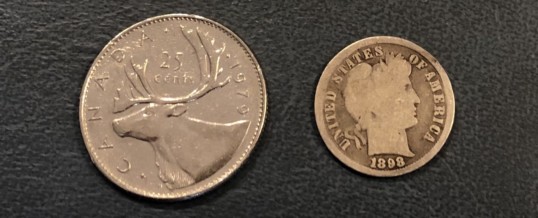
The first coins minted by the U.S. Government were struck in 1783. The use of coins as a means of payment dates to the 5th or 6th Century BCE.
For over 50 years beginning in the 1960s, coins were a means of connecting with my dad.
“Always check your change. Look for wheat pennies, Indian head pennies, buffalo nickels, and any dimes dated 1964 or before,” my dad would frequently remind me.
Wheat pennies are called that because of the sheaf that appears on the back of the cents minted between 1909 and 1958. Indian head pennies were made from 1859 to 1909. Buffalo nickels were minted between 1913 and 1938. Pre-64 dimes have a higher silver content.
My job was to find good, collectible coins and bring them to him to add to the coin collection that was kept in the hall closet.
It was an affordable hobby that, in a way, was a never-ending treasure hunt between a dad and his son.
Beginning when I was old enough to carry money, I learned about coins, including the mintmarks – which indicate where the coin was made. The most common mintmark we see today is Denver, even though the U.S. Mint still also produces coins at San Francisco, Philadelphia, and West Point. There used to be a mint in New Orleans.
The rarity of a coin and where it was minted often have a great impact on its collectability and value. For example, I was told to look for steel pennies. These were pennies made during World War II. Steel was used because copper was needed for the war effort.
A 1943 steel penny with a double mint strike from Denver can be especially valuable.
Over the years it became a contest between the two of us to see who could find the best coin each week.
When I would go to the 7-11 to buy candy to snack on, or gasoline for my lawn business, I would thoroughly look through my change. I would even ask the clerk if there were any wheat pennies in the till and if so, could I have those instead of newer pennies.
On rare occasions, I would hit the jackpot by arriving at a store following someone who had finally cracked open their piggy bank after it had sat for years. Virtually all of the coins in the register would be at least 30 years or older.
I always assumed that was what had happened. Another guess was that someone had inherited a relative’s coin collection and just had no loyalty to the person who left it to them or they simply had no idea that some of the coins were worth far more than face value.
As the years went by, I’d look for specific years of coins. Ones from each birth year of my family members. Graduation dates. The Bicentennial year.
I also began looking for foreign coins. A clerk who wasn’t paying attention would accept a Canadian quarter or a Mexican peso, and in turn, I didn’t pay attention and found it when I went through all of the coins in my pocket at the end of the day. I’ve even received a British 3-pence.
It used to be more common to get a 50-cent piece in change. That almost never happens these days. But, the person who cashed it in likely received it in their Christmas stocking 50 years ago and either cashed it in or also received it when someone passed. Either way, their loss is my gain.
Regarding 50-cent pieces, one game you can play by yourself if you like is to go to your local bank and buy several rolls of 50-cent pieces. It takes awhile to go through all of them, but many times you’ll find old ones that are almost uncirculated and are worth far more than a half-dollar.
Some of the coins my dad and I found over the years just showed up in change we received. It’s rare, but I’ve picked out coins from the 1800s in change I received. Some were worth taking to a coin shop and having graded and put in a protective holder.
My father passed, and I now have the entire coin collection. Every now and then, I’ll take the coins out and look at them. I wonder if the coin I’m holding is one he obtained or one I found.
Either way, I’m still adding to it by going through my coins each night when I empty my pockets. And that isn’t going to change.
©2019 John Moore
John’s book, Write of Passage: A Southerner’s View of Then and Now, is available on Amazon and Barnes and Noble. You can reach John through his website at www.TheCountryWriter.com.
AUG
2019
